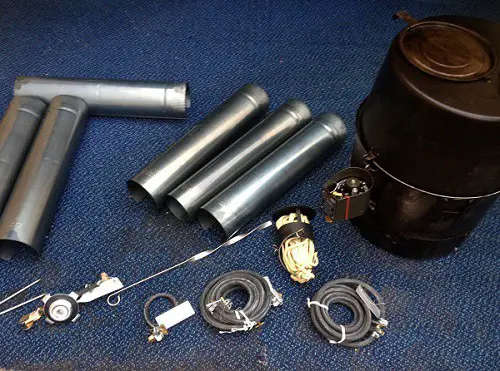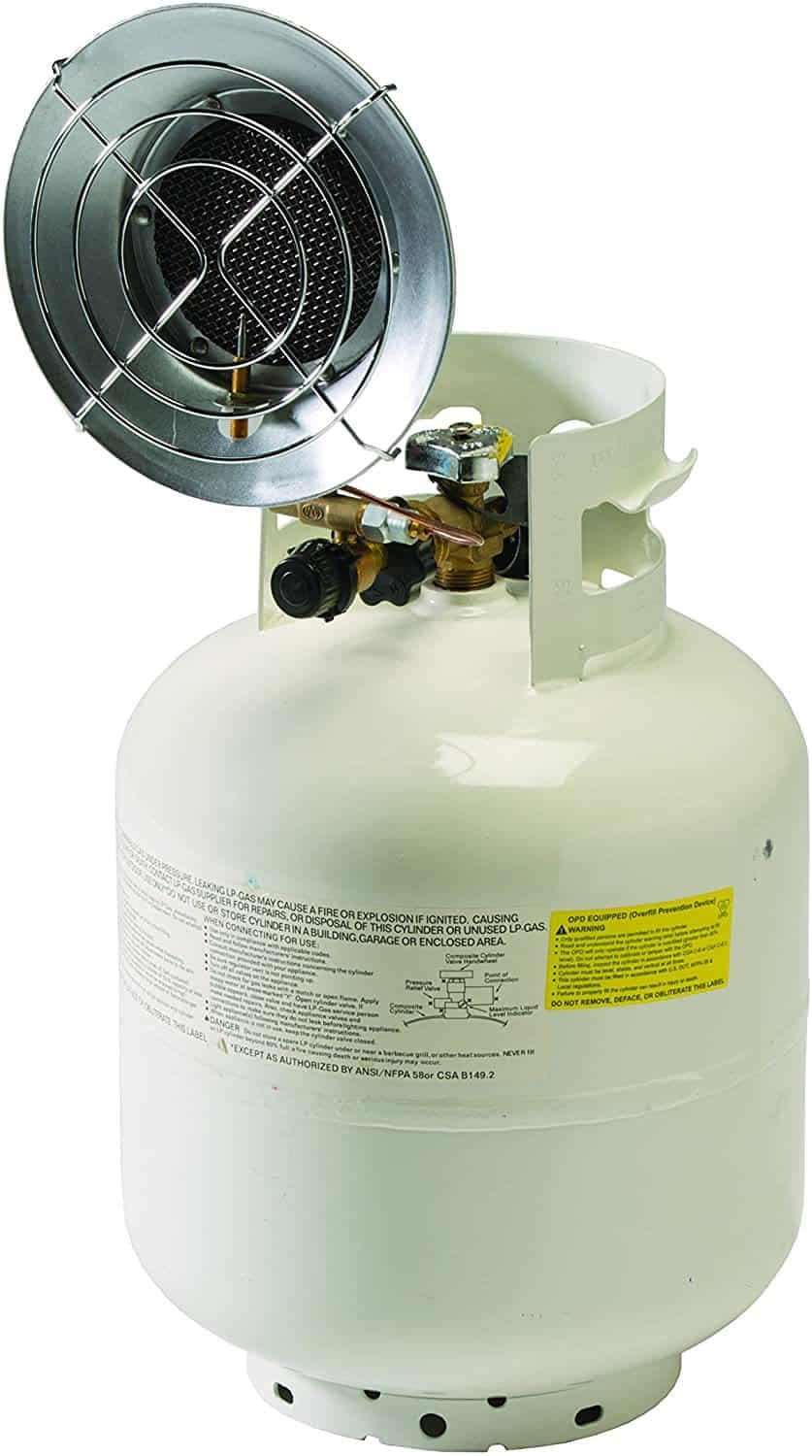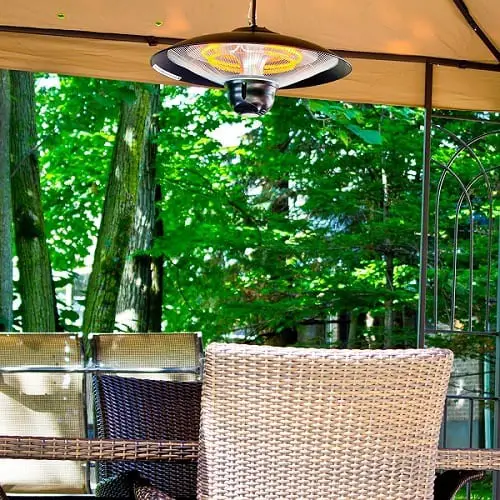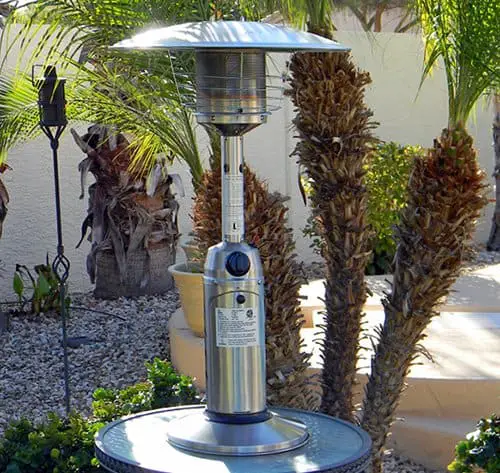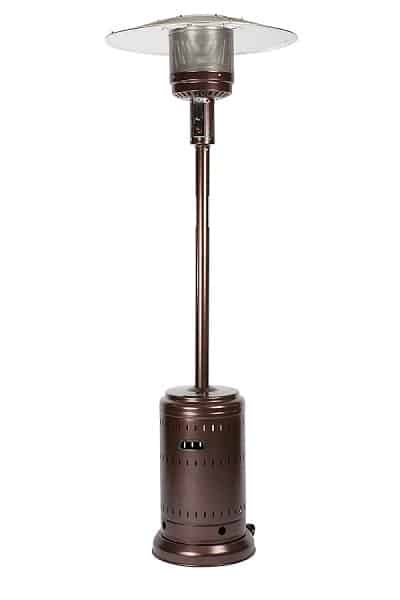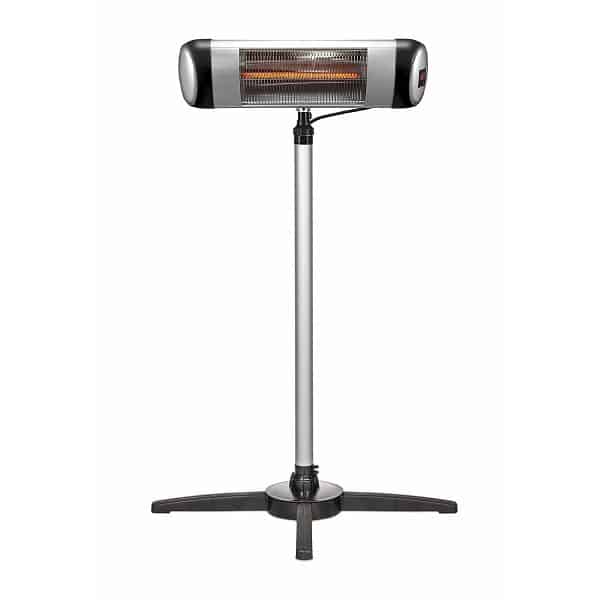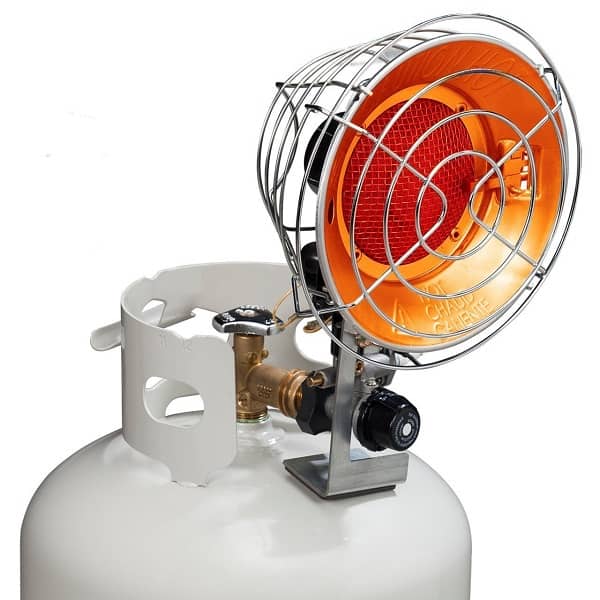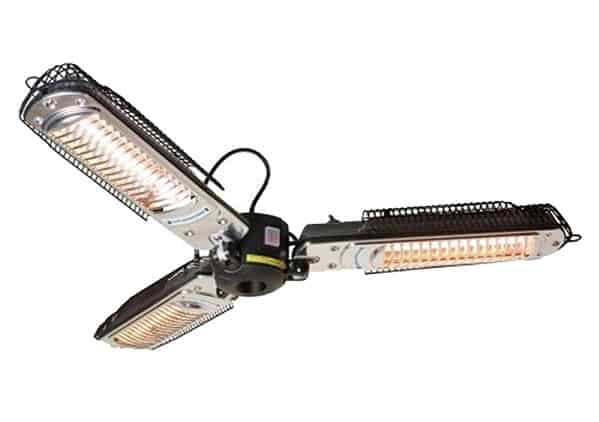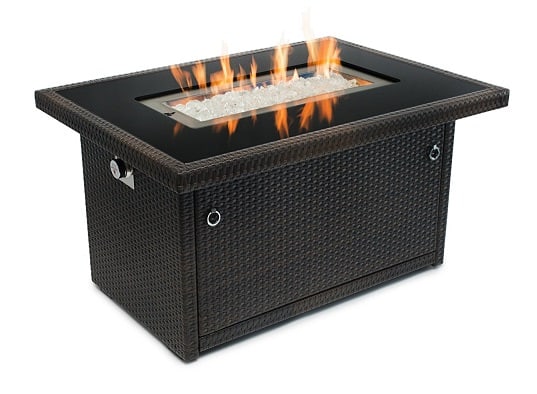[Guide] – Finding the Best Patio Heater for Your Outdoor Living Space

Finding a good patio heater can mean using outdoor living spaces at times when you otherwise wouldn't
Quick Navigation
ALTHOUGH THE MOST ENVIRONMENTALLY-FRIENDLY heater is a nice thick sweater, it isn’t always the most practical and comfortable.
Finding the best patio heater can really transform the way you use your outdoor space during the colder months. Not only does it let you host friends and family outdoors, can also do your favorite activities and still be nice and toasty on those chilly fall and winter evenings.
The Differences Between Patio Heaters
There are 3 main differences in patio heaters. Understanding these and answering deciding what you do and don’t want will help you find a good patio heater. The differences are:
Fuel types
Style types
Size types
1. The Different Fuel Types
When it comes to finding the right patio heaters, there are three different fuel types to choose from, propane, electric, and solid fuel (charcoal, wood etc.). Each has their advantages and disadvantages, based on your particular needs.
Electric Heaters
Electricity might seem like a low-cost form of heat that has the advantage of providing virtually instant heat. These heaters also tend to cool down relatively quickly. Electric heaters are further broken down into two sub-categories:
Long-Wave Infrared
These heaters tend to be quite expensive to operate, but are capable of covering a large area and heating it up quickly.
Halogen
Halogen heaters are significantly less expensive to use, but due to their limited range are not good for larger spaces, let alone the great outdoors of your patio.
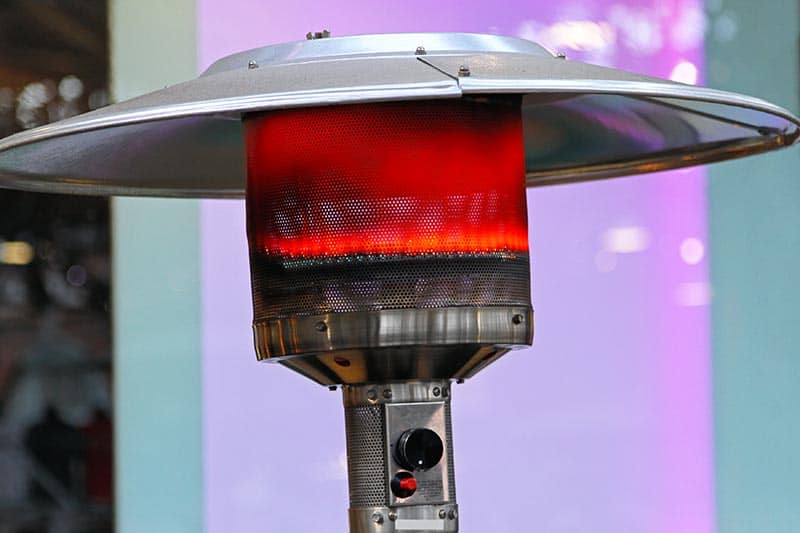
Propane Heaters
Gas powered patio heaters tend to be very effective and can produce significant amounts of heat that cover a large area. But of course, you have to have a ready supply of gas on hand. They are more expensive to operate than electric heaters but have the advantage of providing a steady supply of heat and covering larger areas.
Solid Fuels
This includes chimeneas, fire pits, and wood stoves. These patio heaters look great sitting out on your patio. They are relatively effective at proving plenty of steady heat that can cover a large area. But, you will need to have plenty of fuel on hand as they tend to go through it quite fast. Chimeneas stay hot for hours and can be hard to keep clean. They also produce smoke and may not be the best choice if you have smaller children.
2. Different Styles of Patio Heater
Freestanding Patio Heaters
Freestanding heaters are ideal for those who need to warm up larger areas as they considered to be the most powerful heaters on the market. Most measure between 7 and 8 feet tall and are offered in either a tapered or pyramid style.
Tapered heaters start with a heavy base that holds the tall shaft in place. At the top are a heating element and a metal umbrella cover.
Pyramid heaters are triangular in shape, much lighter and have a flame burning inside a cylindrical tube to produce heat.
Freestanding patio heaters can generally warm an area with a 9-foot diameter. These are the heaviest and can be hard to move around. Some require two people to move and they can be challenging to assemble, even for the experienced builder.
Mounted Patio Heaters
These are great if your patio is right next to your home as they must be attached to a convenient wall or to the ceiling. They are not designed to be portable. The good news is that these heaters are inherently space saving and put out a lot of effective heat.
Getting power to them is easy as they can be wired directly into your home's wiring. Top of the line models come with remote controls that make turning them on and off as well as controlling the temperature easier.
Be sure to check local ordinances to see if you must hire a professional electrician to wire your patio heaters in. Even if there are no laws to prevent you from doing the installation, you should be comfortable with all aspects of the installation for your own safety and that of your family.
Table Top Patio Heaters
These are made to heat smaller areas and are basically a smaller version of the freestanding models. They are lightweight and can easily be moved around your patio. Tabletop heaters are ideal for outdoor meals and family gatherings where you don't need to heat large areas of your patio. You can even take one of these heaters camping with you.
Hanging Patio Heaters
Designed to be hung from the ceiling these heaters are made for use in covered areas such as a gazebo, covered porch or patio, and any other covered area. They are ideal for use in sheds, garages, and other outdoor buildings. Since they hang above the ground, these heaters don't waste any floor space and provide even coverage for the surrounding area.
Fire Pit Patio Heaters
Fire pit heaters look just like a wood burning fire pit but may be powered by wood pellets, propane, even electricity. You never have to worry about searching for firewood or the smoke that burning wood puts off. They tend to be quite expensive, are very heavy, and can be difficult to move around your patio.
3. The Different Sizes
As you look at patio heaters, one of the first things you should notice is that they come in a wide range of sizes, shapes, and styles. Bear in mind that the size of your new patio heater is definitely going to have a major impact on its price. But at the same time, you don't want to waste money buying one that is too small to get the job done.
Here is an idea of basic heat output:
Freestanding – 40,000 BTU – needed due to large areas they heat
Tabletop – 12,000 BTU – because they only have to heat a small area
Mounted – 3,000 BTU – for even smaller areas
But this is just a basic idea of their average maximum output, you should shop for a patio heater based on the size of the area you plan to heat.
How Do I Calculate How Many BTUs I Need?
If you are going to invest in a patio heater for the next cool night, you need to buy one that is going to get the job done. The best way to figure out which one is right for your needs is to do a little (ugh) math. Calculate the size of your patio – measure the length and width of your patio – multiply the two numbers together, this is the area of your patio.
Example: 25 feet x 13 feet = 325 sq. ft.
Now determine how many degrees above the ambient temperature you want the heater to increase the temperature. For the sake of argument, let's say you want to raise is by 10 degrees:
325 x 10 = 3,250 BTUs minimum.
Of course, you may want to buy one a little bigger than your calculations show just in case it gets colder outside than you planned for.
If you are using an electric heater you can calculate the number of watts by taking the radius of the area you wish to heat and multiplying it by 100.
Example: 15 feet x 100 = 1,000 watts
Here again, you may want to go slightly larger than the calculation shows to ensure you have plenty of heat on those chilly evenings.
A Quick Note About Those Domes
You may have noticed that some of the freestanding and tabletop patio heaters have a single dome (the curved metal plate on top) and others have three of them stacked on top of each other. Those with a single dome are generally cheaper than those with three.
A single dome heater is designed to radiate heat downwards, heating a much smaller area, typically directly under the heater.
A triple dome heater is designed to radiate heat in three different directions to provide heat over a much larger area.
Triple dome heaters tend to cost more than single dome units.
The Top 5 Picks for the Top Patio Heater
Fire Sense Hammer Tone Bronze Commercial Patio Heater
Lovely to look at and puts out plenty of heat
Rated at 46,000 BTUs, this freestanding patio heater from Fire Sense is available in a range of colors to suit your outdoor décor. It features piezo electronic ignition with stainless steel burners and a double mantle heating grid. There is a built-in shut off valve in case the heater gets tipped over. It comes with wheels to make it easier to move. Runs on propane with the tank hidden in the pedestal out of sight.
| Pros | Cons |
| Choice of colors | Single dome design keeps heat close by |
| 46,000 BTU output | Made from flimsy metal |
| Easy to maneuver thanks to included wheels | Some manufacturing issues |
Thermo Tiki Deluxe Propane Outdoor Patio Heater - Pyramid Style
Fun to watch the flames while you stay warm
Thermo Tiki Deluxe Propane Outdoor Patio Heater
This patio heater offers a tower of flame that is as much fun to watch as it is to enjoy the heat radiation from it. Made from high-grade steel and aluminum, this heater features a black power-coat finish that will keep it looking good for years. The 50-inch tall ceramic glass flame tube puts on a spectacular show while the pagoda style reflector reflects plenty of heat and firelight. A 20-lb. tank fits in the bottom where it is out of sight.
| Pros | Cons |
| Glass tower puts out plenty of heat and firelight | Most of the heat rises instead of being reflected |
| Powder coated to prevent rust | Poor customer service |
| Push button ignition | Ignition system and burners have issues |
KingMys 1500W Remote Controlled Carbon Infrared Indoor/Outdoor Patio Heater
Interesting design throws directional heat
KingMys 1500W Remote Controlled Indoor/Outdoor Patio Heater
Silent directional heat that uses no fossil fuels, instead this patio heater provides 1,500 watts of heat using electric reflective heat technology. No gas lines or tanks to worry about, no running out of fuel in the middle of the evening. Comes with a convenient remote control and plugs into any standard 110/120V outlet. There are three heat setting modes that allow you to set the amount of heat to match the outside temperature.
| Pros | Cons |
| No gas lines or tanks | Electricity can be spendy |
| 6-foot cord is a bit short for patio use | Fan is noisy |
| Can be used indoors | Not recommended for larger areas |
ProCom PCTT15 Tank-Top Propane Heater, Single Burner, 15,000 BTU
Outdoor heat doesn't get much more basic than this
ProCom PCTT15 Tank-Top Propane Heater
All you need is a 20-lb propane tank and room to sit it on the ground. This heater mounts directly on the top of the tank and puts out up to 15,000 BTU of heat in any direction you point it. It has three temperature settings and comes with a regulator. Unfortunately, you need matches or a stick lighter to light it as it does not have a built-in ignitor.
| Pros | Cons |
| Inexpensive | Very directional heat |
| Space saving | Max output is only 15,000 BTU |
| Runs up to 43 hours on a single tank | Only good for very small areas |
AZ Patio Heaters Electric Patio Heater, Parasol
Perfect for use under that table umbrella
This patio heater is designed to be used under an umbrella and can be used indoors or outside on the patio. It offers up to 1,500 BTU of directional heat. Made of stainless steel with a powder coated finish for long life. Comes with a variable temperature control and is IP certified waterproof. Designed to heat an area up to 15 feet in diameter.
| Pros | Cons |
| Perfect for heating your table under the umbrella | Made just for use under an umbrella |
| Can be left in place all year long | Small heating area |
| Variable temperature controls | Not effective in very cold weather |
One Last Choice
Outland Fire Table, Aluminum Frame Propane Fire Pit Table
Stylish heating for your patio
Outland Fire Table, Aluminum Frame Propane Fire Pit Table
If you are interested in a stylish patio heater that is going to get people talking while keeping them nice and toasty, this might be the perfect one for you. Propane powered with a 35,000 BTU output, this table was a Silver Medal Winner in the 2017 International Design Awards for Best Design in Outdoor Patio Furniture! Safe to use during most fire bans and offers easy lighting and adjustable flame height.
| Pros | Cons |
| Beautiful to look at | Heat is localized |
| Flames are fun to watch | Glass top may not fit in frame |
| Provides plenty of heat | Cannot be used as a table |
Down to the Last BTU
When it comes to choosing the best patio heaters, you need to first think about what you are trying to accomplish and where you plan to use the heater. Each different style is intended for a specific heating need. For myself, I have a Fire Sense freestanding unit on one end and the Outland Fire Table in the middle, together they keep our patio nice and warm on a chilly evening. I hope this information helps you find the heat your patio and family needs.
Thank you for reading this guide on finding the best patio heater for your outdoor living space. If you have any comments of questions, please contact me here

